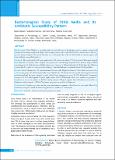Please use this identifier to cite or link to this item:
https://hdl.handle.net/20.500.14356/1660Full metadata record
| DC Field | Value | Language |
|---|---|---|
| dc.contributor.author | Basnet, Rabina | - |
| dc.contributor.author | Sharma, Sudarshan | - |
| dc.contributor.author | Rana, Jid Chani | - |
| dc.contributor.author | Shah, Pradeep Kumar | - |
| dc.date.accessioned | 2023-05-17T10:16:45Z | - |
| dc.date.available | 2023-05-17T10:16:45Z | - |
| dc.date.issued | 2017 | - |
| dc.identifier.citation | BasnetR., SharmaS., RanaJ. C., & ShahP. K. (2017). Bacteriological Study of Otitis Media and Its Antibiotic Susceptibility Pattern. Journal of Nepal Health Research Council, 15(2), 124-129. https://doi.org/10.33314/jnhrc.v15i2.1049 | en_US |
| dc.identifier.issn | Print ISSN: 1727-5482; Online ISSN: 1999-6217 | - |
| dc.identifier.uri | http://103.69.126.140:8080/handle/20.500.14356/1660 | - |
| dc.description | Original Article | en_US |
| dc.description.abstract | Abstract Background: Otitis Media is a prevailing and notorious infection in developing countries causing serious local damage and threating complication. Mainly in developing countries like Nepal, Otitis Media results because of illiteracy, poverty and poor hygiene. The aim of this study was to determine the profile of Otitis Media, its causative agents and their antibiotic susceptibility pattern. Methods: The study included 263 pus samples from 240 patients attending ENT department of Bharatpur hospital from May 2015 to January 2016. Samples were processed in microbiology department for bacteria using standard operating protocol. Antibiotic susceptibility testing was performed for all bacterial isolates by Kirby Bauer disc diffusion method and the results were interpreted according to clinical and laboratory standard institute (CLSI) guideline. Results: Out of 240 patients, 121 were female and 119 were male. Highest incidence of Otitis Media was observed in 1-10 year age group. Out of 263 samples taken from 240 patients, 216 showed bacterial growth. Gram negative bacteria predominated and the most common bacteria isolated were Staphylococcus aureus 36.11% followed by Pseudomonas aeruginosa 33.33% and Coagulase Negative Staphylococci 8.08%. All bacterial isolates were sensitive to gentamycin. Staphylococcus aureus was sensitive to Amikacin and gentamycin. All gram negative bacterial isolates were sensitive to Imipenem and gentamycin. 100% of Pseudomonas aeruginosa was sensitive to Imipenem. Conclusions: Staphylococcus aureus was the most predominant organism isolated from the pus swab followed by Pseudomonas aeruginosa and all the isolated organisms were sensitive to Gentamycin. Keywords: Antibiotic; bacteria; otitis media; staphylococcus aureus. | en_US |
| dc.language.iso | en | en_US |
| dc.publisher | Nepal Health Research Council | en_US |
| dc.relation.ispartofseries | May-Aug, 2017;1049 | - |
| dc.subject | Antibiotic | en_US |
| dc.subject | Bacteria | en_US |
| dc.subject | Otitis media | en_US |
| dc.subject | Staphylococcus aureus | en_US |
| dc.title | Bacteriological Study of Otitis Media and Its Antibiotic Susceptibility Pattern | en_US |
| dc.type | Journal Article | en_US |
| Appears in Collections: | Vol 5 No 2 Issue 36 May-Aug 2017 | |
Files in This Item:
| File | Description | Size | Format | |
|---|---|---|---|---|
| 1049-Article Text-2324-1-10-20170908.pdf | Fulltext Download | 234.16 kB | Adobe PDF |  View/Open |
Items in DSpace are protected by copyright, with all rights reserved, unless otherwise indicated.
